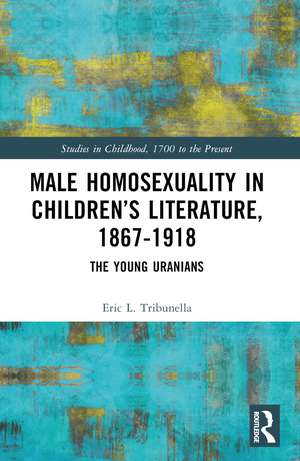Male Homosexuality in Children’s Literature, 1867–1918: The Young Uranians: Studies in Childhood, 1700 to the Present
Autor Eric L. Tribunellaen Limba Engleză Paperback – 28 noi 2024
| Toate formatele și edițiile | Preț | Express |
|---|---|---|
| Paperback (1) | 310.85 lei 6-8 săpt. | |
| Taylor & Francis – 28 noi 2024 | 310.85 lei 6-8 săpt. | |
| Hardback (1) | 1003.75 lei 6-8 săpt. | |
| Taylor & Francis – 20 iul 2023 | 1003.75 lei 6-8 săpt. |
Din seria Studies in Childhood, 1700 to the Present
-
 Preț: 386.77 lei
Preț: 386.77 lei -
 Preț: 310.22 lei
Preț: 310.22 lei -
 Preț: 326.49 lei
Preț: 326.49 lei -
 Preț: 489.26 lei
Preț: 489.26 lei -
 Preț: 484.47 lei
Preț: 484.47 lei -
 Preț: 489.26 lei
Preț: 489.26 lei -
 Preț: 485.07 lei
Preț: 485.07 lei -
 Preț: 489.26 lei
Preț: 489.26 lei - 18%
 Preț: 1005.01 lei
Preț: 1005.01 lei -
 Preț: 489.26 lei
Preț: 489.26 lei - 26%
 Preț: 819.90 lei
Preț: 819.90 lei -
 Preț: 469.34 lei
Preț: 469.34 lei -
 Preț: 449.41 lei
Preț: 449.41 lei -
 Preț: 436.14 lei
Preț: 436.14 lei -
 Preț: 489.26 lei
Preț: 489.26 lei -
 Preț: 489.26 lei
Preț: 489.26 lei -
 Preț: 469.34 lei
Preț: 469.34 lei -
 Preț: 481.43 lei
Preț: 481.43 lei -
 Preț: 449.41 lei
Preț: 449.41 lei -
 Preț: 469.34 lei
Preț: 469.34 lei - 18%
 Preț: 1007.82 lei
Preț: 1007.82 lei - 18%
 Preț: 1003.99 lei
Preț: 1003.99 lei -
 Preț: 409.73 lei
Preț: 409.73 lei - 18%
 Preț: 1064.98 lei
Preț: 1064.98 lei - 25%
 Preț: 767.47 lei
Preț: 767.47 lei - 18%
 Preț: 1000.27 lei
Preț: 1000.27 lei -
 Preț: 469.34 lei
Preț: 469.34 lei - 13%
 Preț: 338.33 lei
Preț: 338.33 lei -
 Preț: 469.34 lei
Preț: 469.34 lei - 18%
 Preț: 1060.25 lei
Preț: 1060.25 lei - 18%
 Preț: 1058.65 lei
Preț: 1058.65 lei - 17%
 Preț: 233.98 lei
Preț: 233.98 lei - 18%
 Preț: 1109.18 lei
Preț: 1109.18 lei
Preț: 310.85 lei
Nou
Puncte Express: 466
Preț estimativ în valută:
59.51€ • 61.23$ • 50.16£
59.51€ • 61.23$ • 50.16£
Carte tipărită la comandă
Livrare economică 01-15 martie
Preluare comenzi: 021 569.72.76
Specificații
ISBN-13: 9781032441139
ISBN-10: 1032441135
Pagini: 214
Ilustrații: 12
Dimensiuni: 152 x 229 mm
Greutate: 0.4 kg
Ediția:1
Editura: Taylor & Francis
Colecția Routledge
Seria Studies in Childhood, 1700 to the Present
Locul publicării:Oxford, United Kingdom
ISBN-10: 1032441135
Pagini: 214
Ilustrații: 12
Dimensiuni: 152 x 229 mm
Greutate: 0.4 kg
Ediția:1
Editura: Taylor & Francis
Colecția Routledge
Seria Studies in Childhood, 1700 to the Present
Locul publicării:Oxford, United Kingdom
Public țintă
Academic, Postgraduate, and Undergraduate AdvancedNotă biografică
Eric L. Tribunella, Professor of English, teaches children’s and young adult literature and gay studies at the University of Southern Mississippi. He is the author of Melancholia and Maturation: The Use of Trauma in American Children’s Literature (2010), the co-author of Reading Children’s Literature: A Critical Introduction (2013/2019), and the co-editor of A de Grummond Primer: Highlights of the Children’s Literature Collection (2021). He edited a critical edition of Edward Prime-Stevenson’s 1891 boys’ novel Left to Themselves (2016), and among his various journal articles and book chapters, he contributed the essay on children’s literature and childhood studies to the Cambridge History of Gay and Lesbian Literature (2014).
Cuprins
List of Figures
Acknowledgments
Introduction Uncovering the Early History of Gay Children’s Literature
Chapter 1 New York City and the Proto-Uranian Street Boys of Alger’s Ragged Dick Series
Chapter 2 Boys as Noble Uranians: Eduard Bertz’s The French Prisoners and the Discourse of Sexology
Chapter 3 Suicide, Self-Sacrifice, and Uranian Schoolboys in Howard Sturgis’s Tim and Horace Vachell’s The Hill
Chapter 4 Between Boys: Coding Young Uranians in Edward Prime-Stevenson’s Left to Themselves and White Cockades
Chapter 5 The Adult Tutor and the Young Uranian: Greek Love in John Gambril Nicholson’s In Carrington’s Duty-Week and The Romance of a Choir Boy
Chapter 6 E.F. Benson’s David Blaize Books and Boys as the "Third Sex"
Conclusion "The Future May be Trusted to Decide": Boy Books and the Possibilities of Gay Children’s Literature
Index
Acknowledgments
Introduction Uncovering the Early History of Gay Children’s Literature
Chapter 1 New York City and the Proto-Uranian Street Boys of Alger’s Ragged Dick Series
Chapter 2 Boys as Noble Uranians: Eduard Bertz’s The French Prisoners and the Discourse of Sexology
Chapter 3 Suicide, Self-Sacrifice, and Uranian Schoolboys in Howard Sturgis’s Tim and Horace Vachell’s The Hill
Chapter 4 Between Boys: Coding Young Uranians in Edward Prime-Stevenson’s Left to Themselves and White Cockades
Chapter 5 The Adult Tutor and the Young Uranian: Greek Love in John Gambril Nicholson’s In Carrington’s Duty-Week and The Romance of a Choir Boy
Chapter 6 E.F. Benson’s David Blaize Books and Boys as the "Third Sex"
Conclusion "The Future May be Trusted to Decide": Boy Books and the Possibilities of Gay Children’s Literature
Index
Descriere
Read alongside major developments in English- and German-language sexology, work by Stevenson and other gay writers who wrote for children, can be understood as participating in the construction and dissemination of the discourse of sexuality and as constituting the figure of the young Uranian as central to modern gay identity.
